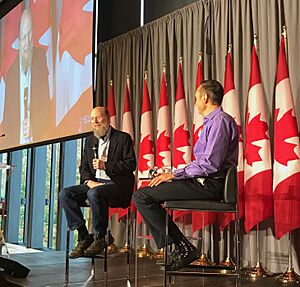Richard S. Sutton facts for kids
Quick facts for kids
Richard S. Sutton
FRS FRSC
|
|
|---|---|

Sutton in 2021
|
|
| Born | 1957/1958 (age 67–68) Ohio, U.S.
|
| Citizenship | Canadian |
| Education | Stanford University (BA) University of Massachusetts, Amherst (MS, PhD) |
| Known for | Temporal difference learning, Dyna, Options, GQ(λ) |
| Awards | AAAI Fellow (2001) President's Award (INNS) (2003) Royal Society of Canada Fellow (2016) Turing Award (2025) |
| Scientific career | |
| Fields | Artificial intelligence Reinforcement learning |
| Institutions | University of Alberta |
| Thesis | Temporal credit assignment in reinforcement learning (1984) |
| Doctoral advisor | Andrew Barto |
| Doctoral students | David Silver Doina Precup |
Richard Stuart Sutton, born in 1957 or 1958, is a Canadian computer scientist. He teaches computing science at the University of Alberta. He is also a top advisor at the Alberta Machine Intelligence Institute and a scientist at Keen Technologies. Sutton is known as one of the main creators of modern reinforcement learning. This is a key part of artificial intelligence. He made important discoveries like temporal difference learning and policy gradient methods.
Contents
Early Life and Education
Richard Sutton was born in Ohio, USA. He grew up in Oak Brook, Illinois, near Chicago.
He earned his first degree in psychology from Stanford University in 1978. Later, he studied computer science at the University of Massachusetts Amherst. He received his master's degree in 1980 and his PhD in 1984. His main teacher was Andrew Barto. Sutton's PhD paper was about how computers learn over time. It introduced ideas like "actor-critic architectures."
Sutton was inspired by Harry Klopf's ideas from the 1970s. Klopf believed that simple "supervised learning" was not enough for true AI. He thought that learning by "trial and error" was very important. This idea helped Sutton focus on reinforcement learning.

Richard Sutton's Career Journey
In 1984, Sutton worked as a researcher at the University of Massachusetts. From 1985 to 1994, he was a key staff member at GTE in Waltham, Massachusetts. He then spent three years as a senior research scientist at the University of Massachusetts Amherst. From 1998 to 2002, Sutton worked at AT&T Shannon Laboratory. He was a main technical staff member in their artificial intelligence department.
Since 2003, he has been a professor at the University of Alberta. He led the Reinforcement Learning and Artificial Intelligence Laboratory there until 2018. In 2017, Sutton also joined Deepmind. He became a distinguished research scientist and helped start their Edmonton office. Sutton became a Canadian citizen in 2015.
Understanding Reinforcement Learning
In the early 1980s, Sutton joined Andrew Barto at UMass. They wanted to understand how brain cells learn. This idea came from computer scientist A. Harry Klopf. Sutton and Barto used math to develop this concept for artificial intelligence. This became known as reinforcement learning. It is now a key part of AI.
Barto and Sutton used a math idea called Markov decision processes (MDP). This helped explain how computer "agents" make choices. These agents act in changing environments and get "rewards" for their actions. In older MDP theories, agents knew everything about their environment. But Sutton and Barto's method allowed the environment to be unknown. This made their reinforcement learning useful for many more problems.
Sutton returned to Canada in the 2000s. He kept working on reinforcement learning. This field grew in academic circles. One of its first big real-world uses was Google's AlphaGo program. AlphaGo used reinforcement learning to beat the human champion in the game Go. Barto and Sutton are seen as pioneers of modern reinforcement learning. Their work is a foundation for today's AI boom.
In 2019, Sutton wrote an essay about AI research. He said that building AI based on "how we think we think" often fails. He argued that "general methods that use computing power" are usually best. He believed this approach beats efforts that rely on human knowledge. This applies to fields like computer vision, speech recognition, and games like chess or Go.
In 2023, Sutton teamed up with John Carmack. They announced a partnership to develop artificial general intelligence (AGI). AGI is a type of AI that can understand and learn any intellectual task that a human being can.
Awards and Recognitions
Richard Sutton has received many honors for his work. He became a fellow of the Association for the Advancement of Artificial Intelligence (AAAI) in 2001. This was for his important work in machine learning. In 2003, he received the President's Award. In 2013, he got an award for outstanding research from the University of Massachusetts Amherst.
In 2025, he received the Turing Award with Andrew Barto. This is one of the highest honors in computer science. They won for creating the main ideas and methods of reinforcement learning.
Sutton was elected a Fellow of the Royal Society of Canada in 2016. In 2021, he was also elected a Fellow of the Royal Society of London.
Key Publications
- Sutton, R. S., Barto, A. G., Reinforcement Learning: An Introduction. MIT Press, 1998. (Second edition MIT Press 2018).
- Sutton, R. S. (Ed.), Reinforcement Learning. Kluwer Academic Press, 1992.
- Miller, W. T., Sutton, R. S., Werbos, P. J. (Eds.), Neural Networks for Control. MIT Press, 1991.

